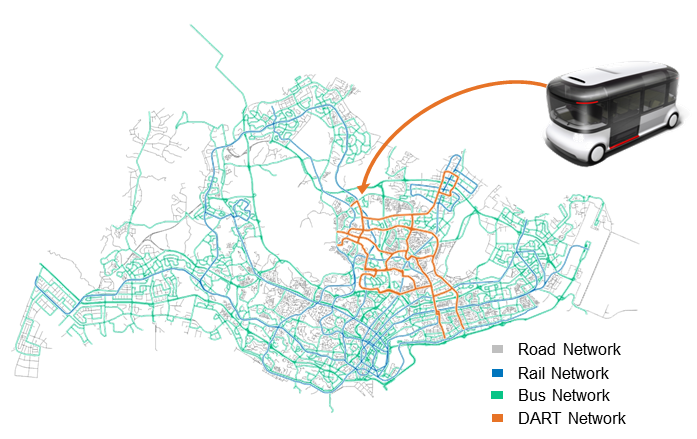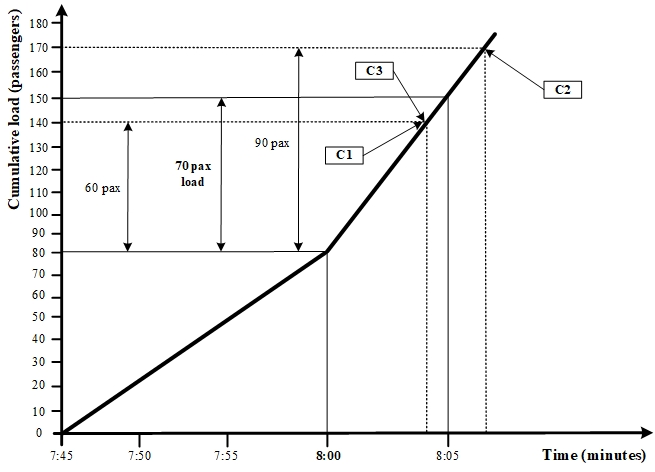- QUASAR
- AquaCycle
- Proteins4Singapore
- Singapore's Pathway to Carbon Neutrality
- CellFACE
- LightSPAN
- Computational Modelling Group
- Energy and Power Systems Group
- SITEM - Singapore Integrated Transport and Energy Model
- Past Projects
RRT-1 — Design and Development of DART Network
A new methodology has been developed for integrated network design and scheduling. This methodology optimizes the deployment of the DART concepts and the integration with the existing Public Transport (PT) networks in Singapore. The outcome is a set of DART network configurations including routes, vehicle capacities, platooning concept, timetables and standardized evaluation techniques.
The research includes the following tasks:
- Spatial and temporal analysis of supply and demand data for given region, and selection of the study area for optimal DART implementation
- Objective-specific DART network configurations incorporating viewpoints of operators and passengers
- Scheduling and platooning strategies aiming at enhancing connectivity, synchronisation and coordination of the DART network
- Systematic evaluation of DART network involving multiple stakeholders (users, operators and authority) with multiple aspects (socio-economic and environmental)
The developed methodologies for the design and integration of new public transport layer into the existing PT system will be investigated further. Different DART network configurations will be created, their characteristics and impacts together with the scheduling and vehicle Platooning concept on the whole public transport system will be analysed. Moreover, an improved demand estimation for the DART service in the selected area will be conducted.
The scheduling and routing of DART vehicle modules in the context of dynamic and stochastic operations will be explored for the DART service. Finally, in accordance with the up-streamed development, an economic sub-model principally a cost-benefit / cost-efficiency analysis of DART system will be developed.
Figure 1: Transport modes and network layers
Identification of Study Area
A hierarchical framework that incorporates a set of urban planning principles has been developed to identify the most suitable study area for the DART system. First, candidate corridors are selected. This is done by conducting a qualitative and quantitative analysis of the ridership, travelling speed and line capacity of the existing public transport modes as well as future transport plans. Based on the selected corridors, the study area is determined by considering several factors, such as local transport policies, population density, land-use characteristics, coordination and integration with the MRT/LRT systems.
 Figure 2: Study area selection method
Figure 2: Study area selection methodDART Network Design
The public transport network is predominantly designed by transit planning agencies and authorities based on expert opinions and local service level guidelines. However, human eyes, basic planning guidelines and service standards are not capable enough to encapsulate system level public transport network planning. Therefore, for DART network design, an algorithmic approach is followed, where perspectives of both users and operators are considered. Following these perspectives, different public transport network configurations are designed. The network which offers the best compromise between user and operator perspective is finally selected as the base network for DART.
Figure 3: DART network configurations
Timetabling and Fleet Planning
Through its system properties the DART system enables a multi-purpose, flexible use of available urban road space as well as transport capacity for persons and goods. The main aim of timetabling and fleet planning is to develop a combined graphical and quantitative mathematical model to analyse and optimise the timetable, vehicle scheduling and platooning activities in the DART system so as to improve the integration and service quality of the DART system with increased connectivity, synchronization, and coordination towards a far more user-oriented, system-optimal, smart and sustainable future urban mobility.

Figure 4: Strategies for assigning the number of vehicle modulesHolistic Evaluation of Multi-modal Integrated Public Transport System
The central idea of introducing DART is to complement the existing system and not to compete with it. Therefore, this additional mode of public transport is conceptualized such that it is integrated with existing modes like buses and MRT. This makes the overall system significantly complex not only in terms of synchronous operations but also the way users interact with the system. Therefore, this study aims to make a general assessment of the overall system from its multiple stakeholders’ (user, operator & authority) point of view including socio-economic and environmental aspects and the interrelationships among them. For this, a System Dynamics or System’s Thinking approach is taken to model the interactions among stakeholders and socio-economic and environmental aspects.

